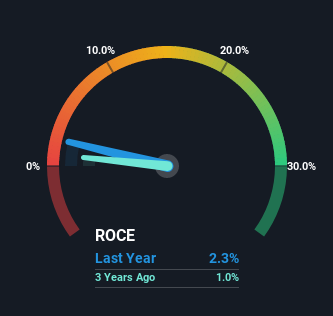- Sweden
- /
- Oil and Gas
- /
- OM:CCOR B
Investors Will Want Concordia Maritime's (STO:CCOR B) Growth In ROCE To Persist

Did you know there are some financial metrics that can provide clues of a potential multi-bagger? In a perfect world, we'd like to see a company investing more capital into its business and ideally the returns earned from that capital are also increasing. Put simply, these types of businesses are compounding machines, meaning they are continually reinvesting their earnings at ever-higher rates of return. So on that note, Concordia Maritime (STO:CCOR B) looks quite promising in regards to its trends of return on capital.
Understanding Return On Capital Employed (ROCE)
If you haven't worked with ROCE before, it measures the 'return' (pre-tax profit) a company generates from capital employed in its business. To calculate this metric for Concordia Maritime, this is the formula:
Return on Capital Employed = Earnings Before Interest and Tax (EBIT) ÷ (Total Assets - Current Liabilities)
0.023 = kr21m ÷ (kr1.7b - kr773m) (Based on the trailing twelve months to September 2022).
Thus, Concordia Maritime has an ROCE of 2.3%. In absolute terms, that's a low return and it also under-performs the Oil and Gas industry average of 14%.
Check out the opportunities and risks within the SE Oil and Gas industry.

While the past is not representative of the future, it can be helpful to know how a company has performed historically, which is why we have this chart above. If you'd like to look at how Concordia Maritime has performed in the past in other metrics, you can view this free graph of past earnings, revenue and cash flow.
So How Is Concordia Maritime's ROCE Trending?
It's great to see that Concordia Maritime has started to generate some pre-tax earnings from prior investments. The company was generating losses five years ago, but now it's turned around, earning 2.3% which is no doubt a relief for some early shareholders. Additionally, the business is utilizing 67% less capital than it was five years ago, and taken at face value, that can mean the company needs less funds at work to get a return. Concordia Maritime could be selling under-performing assets since the ROCE is improving.
For the record though, there was a noticeable increase in the company's current liabilities over the period, so we would attribute some of the ROCE growth to that. Essentially the business now has suppliers or short-term creditors funding about 46% of its operations, which isn't ideal. Given it's pretty high ratio, we'd remind investors that having current liabilities at those levels can bring about some risks in certain businesses.
In Conclusion...
From what we've seen above, Concordia Maritime has managed to increase it's returns on capital all the while reducing it's capital base. And since the stock has fallen 45% over the last five years, there might be an opportunity here. With that in mind, we believe the promising trends warrant this stock for further investigation.
On a final note, we've found 1 warning sign for Concordia Maritime that we think you should be aware of.
If you want to search for solid companies with great earnings, check out this free list of companies with good balance sheets and impressive returns on equity.
If you're looking to trade Concordia Maritime, open an account with the lowest-cost platform trusted by professionals, Interactive Brokers.
With clients in over 200 countries and territories, and access to 160 markets, IBKR lets you trade stocks, options, futures, forex, bonds and funds from a single integrated account.
Enjoy no hidden fees, no account minimums, and FX conversion rates as low as 0.03%, far better than what most brokers offer.
Sponsored ContentNew: AI Stock Screener & Alerts
Our new AI Stock Screener scans the market every day to uncover opportunities.
• Dividend Powerhouses (3%+ Yield)
• Undervalued Small Caps with Insider Buying
• High growth Tech and AI Companies
Or build your own from over 50 metrics.
Have feedback on this article? Concerned about the content? Get in touch with us directly. Alternatively, email editorial-team (at) simplywallst.com.
This article by Simply Wall St is general in nature. We provide commentary based on historical data and analyst forecasts only using an unbiased methodology and our articles are not intended to be financial advice. It does not constitute a recommendation to buy or sell any stock, and does not take account of your objectives, or your financial situation. We aim to bring you long-term focused analysis driven by fundamental data. Note that our analysis may not factor in the latest price-sensitive company announcements or qualitative material. Simply Wall St has no position in any stocks mentioned.
About OM:CCOR B
Concordia Maritime
Concordia Maritime AB (publ) operates as a tanker shipping company in Sweden and internationally.
Flawless balance sheet with acceptable track record.
Similar Companies
Market Insights
Community Narratives




